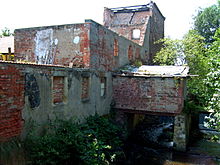Rödermühle Saathain
The Rödermühle is located on the former course of the Großer Röder in Saathain , a district of the southern Brandenburg municipality of Röderland .
history
As the pastor and historian Wolfgang Bastian wrote in a letter to the mill owner Weber in 1941, the Rödermühle in the Neusaathain settlement was first documented in the 16th century in fiefdoms from the Saathain rule . The building was increased to four storeys in 1932 and had a storage facility as well as a three-meter-wide crop wheel with a diameter of 5.5 meters, three wooden wreaths and sheet metal shovels.
The oldest known miller is Hans Lindener, who appeared in the town's baptismal registers from 1649 and died in 1664. He was followed by his son-in-law Martin Zehrfeld. From 1695 the mill went into the possession of Johann Gebhardt and then to his brother Martin, who later leased the water mill in neighboring Prieschka . Subsequently, the Rödermühle, which was listed in the Saxon directory in 1791 as a water mill with three gears, changed hands several times. In 1840 the mill finally came into the possession of the Weber family, where it remained until 1993. After the unexpected death of the master miller Oskar Kurt Weber in 1973, his son Hans-Joachim Weber did not receive a business license despite many efforts and the mill was stopped in 1974.
Shortly after the fall of the Wall , the property was sold and divided. At this point in time, the mill was already falling into disrepair. While part of the property passed into the possession of the Berlin- born Schenk family in 1995 , who opened a tree nursery here , the other part with the historic water mill was acquired by hobby historian Werner Weigold. Weigold began restoring the historic building here and had the vision of generating electricity with the Rödermühle. The production of 168,000 kWh of electricity should be possible, of which 148,000 kWh should be fed into the public grid. In addition, the building was to be opened for guided tours and some of it was to be put back into operation.
On the night of September 20-21, 1997, however, a major fire destroyed the mill and only the foundation walls remained of the structure. Weigold came to the hospital with smoke inhalation and shock. His project was later abandoned and the remaining ruins were finally acquired in 2006 by the nursery owner Marco Schenk (* 1966; † 2013). Since then, the remains of the mill have been thoroughly renovated and the building has been rebuilt.
Culture and tourism
On the premises of the Saathainer Rödermühle there is a gallery, which was opened in 1998 and is used for exhibitions by regional artists , in the premises of the former carriage shed and the lodging horse stable. There is also a summer café and a petting zoo here.
Sources and evidence
- Wolfgang Bastian : "Die Rödermühle", excerpt from a presumably no longer existing chronicle on the history of the town of Saathain from 1941, published in "Die Schwarze Elster", No. 17 (594), 1984
- Wilfried Höntzsch: The Rödermühle to Saathain. In: Home calendar for the old district of Bad Liebenwerda, the Mückenberger Ländchen, outskirts on Schraden and Uebigau-Falkenberg . Ed .: Arbeitsgemeinschaft für Heimatkunde e. V. Bad Liebenwerda. Bad Liebenwerda 1998, ISBN 3-932913-01-9 , p. 224-234 .
- Manfred Woitzik: “First come - first served” a cultural history of mills in the Elbe-Elster district . Ed .: Cultural Office of the Elbe-Elster District. Herzberg, S. 133 to 134 .
- Homepage of the Saathainer Rödermühle
Web links
Coordinates: 51 ° 27 ' N , 13 ° 27' E


